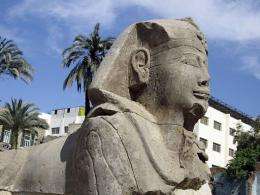A handout images made available by the Egyptian Supreme Council of Antiquities shows Egyptian workers standing next to one of the 12 sphinxes dating from the reign of the last Pharaonic dynasty, Nectanebo I (380-362 BC), discovered by Egyptian archaeologists along a sphinx-lined road in Luxor, southern Egypt.
Egyptian archaeologists have discovered a sphinx-lined road in Luxor that led to the temple of Mut, the ancient goddess worshipped as a mother, the culture minister said on Monday.
Faruq Husni said in a statement that 12 sphinxes were found along the road, which runs east to west adjoining the already discovered Kabash path that connects the temples of Luxor and Karnak from north to south.
The sphinxes were inscribed with the name Nectabo I, the founder of the last Pharaonic dynasty who died in 362 BC. Most of them were missing their heads.
"This discovery marks the first time that archaeology has revealed this route, which is mentioned in many ancient texts," the statement said.
The expedition had already unearthed much of the Kabash path, also known as Sphinx Alley, which was built by the prodigiously wealthy Pharaoh Amenhotep III, who ruled about 3,400 years ago, to connect the vast Karnak temple in ancient Thebes to the Luxor Temple.
Sphinxes were built on either side of the road, alongside chapels stocked with offerings for the deities.
Ancient Egyptians promenaded along it once a year with the statues of Amun, the central god, and his wife Mut in a symbolic re-enactment of the deities' marriage.
The road was later used by the Romans and is believed to have been renovated by the Ptolemic Queen Cleopatra, who left her cartouche, an inscribed hieroglyphic.
(c) 2010 AFP























